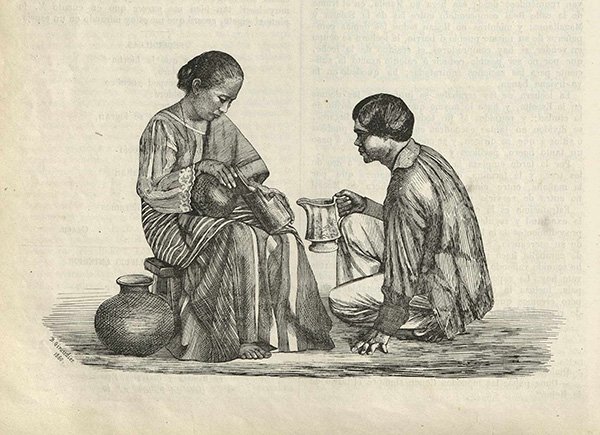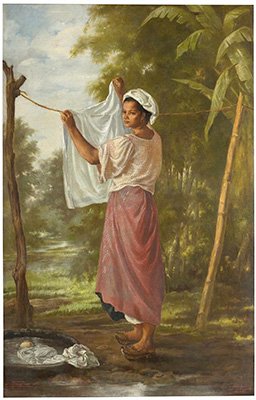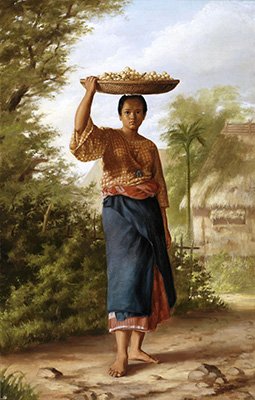Women Workers of 19th Century Manila, Part 2
This Women’s Month, the Research, Publications, and Heraldry Division of the NHCP is presenting a series of historical images depicting the various livelihoods of Filipinas in the 19th century. This proves that women, then and now, have always worked alongside men as an indispensable part of the country’s labor force. This gallery also gives us a glimpse of women’s jobs that were common during the colonial period but have now faded into memory, as well as livelihoods that persist today.
𝗗𝗮𝘆 𝟳: 𝗟𝗲𝗰𝗵𝗲𝗿𝗮

Picture by Baltasar Giraudier and published in La Ilustración Filipina, 1 August 1860, Biblioteca Nacional de España
No, her job was not to curse at someone.
The lechera (from the Spanish word leche or milk) was a busy job during the 19th century, at a time when household refrigerators had yet to be introduced in the Philippines (they came in the 1950s).
As early as 3:00 a.m., the lechera was already headed to Manila from her home in Makati, Caloocan or Gagalangin, Tondo. She carried on her head a small jar with the milk, and a chupa or bottle to transfer the milk. According to an 1860 article in La Ilustración Filipina where the image below is sourced, the lechera had amazing traits: she was always punctual in delivering milk to her loyal customers, she moved quickly, and had a healthy and strong body to do her work. The lecheras and their male counterparts, the lecheros, spent the day moving around the city together delivering milk, often finishing the day's job at 6:00 p.m.
One interesting note was that the price of milk did not change over the years, remaining at 6 cuartos per chupa. This resulted in a running joke about the milk not being pure (mixed with am or rice water, or coconut) to make up for the price. The joke gained popularity and was even featured in an 1882 comedy play. Could this be the reason why "leche" became a swear word? To curse at someone for being a liar?
𝗗𝗮𝘆 𝟴: 𝗟𝗮𝘃𝗮𝗻𝗱𝗲𝗿𝗮

Painting by Miguel Zaragosa y Aranquinza, 1875, displayed at the Museo Nacional del Prado
Too tired or busy (or rich) to wash your dirty laundry? Then hand them to your lavandera!
As with today's generation, Filipinos during the colonial period were quite fussy regarding hygiene and cleanliness, as evidenced by regular bathing and the washing of clothes. According to historian Stephanie Coo, clean clothes were a status symbol. One could already tell if a person was a laborer if their clothes were dirty from working. In contrast, the rich always attended social gatherings wearing a fresh set of clothes. Doña Consolación, a social elite in Rizal's Noli Me Tangere and TV series Maria Clara at Ibarra, was herself a lavandera before marrying an alférez or Spanish official.
Hence, while ordinary people washed their own clothes, the rich like Doña Consolación employed a lavandera. She could even retain the laundress as in-house to tend to her finely embroidered and delicate-fabric habiliments. Despite her job title, the lavandera's work was not limited to washing clothes; she also ironed them, polished shoes and accessories, and maintained and repaired her employer's apparel.
Like the costureras (seamstresses), lavanderas earned a measly sum (4 pesos monthly in 1880), which forced some of them to engage in prostitution for additional income. Doña Consolación is an example of a poor lavandera who managed to get out of poverty.
Interestingly, the lavandera was often featured in illustrations. In addition to the featured 1875 painting by Miguel Zaragosa, Fernando Amorsolo also did a number of works featuring Filipina lavanderas in his signature landscapes.
𝗗𝗮𝘆 𝟵: 𝗠𝗮𝗲𝘀𝘁𝗿𝗮

Picture from Ada: The Life of Librada Avelino or the Development of a Soul by Francisco Varona, 1935. Colorized by Adrian Navarro.
Remember your very first teacher? You should – it’s your mother!
Or at least it was the norm during the 19th century. Back when public education was not yet widespread, it was usually the mother, or the women in the family or community, who provided early (or sometimes, the only) education for sons and daughters, using basic reading materials such as the cartilla, catón, catecismo and silabario (simple reading materials). Even the great minds of that century like Jose Rizal were first taught by their mothers. Andres Bonifacio was taught by his aunt. No wonder the mother is called “ilaw ng tahanan (light of the home).”
Ironically, there were only a few maestras or women schoolteachers during the Spanish period. They were often from affluent families who owned or taught in all-girls schools. An example was Margarita Lopez who opened a school in Tondo and prepared girls for teaching licenses. One of her students was Librada Avelino (whose portrait was featured in this post together with her lifelong collaborator Carmen de Luna), who passed the civil exam for teaching in 1889 and became the first maestra to receive a teaching certificate. Following her maestra, Librada opened a school for girls, and much later, established the Centro Escolar University in 1907.
The role of licensed maestras spearheaded by Librada Avelino changed drastically during the American occupation. The opening of more public schools demanded more schoolteachers and the establishment of normal schools that professionalized the teaching occupation.
𝗗𝗮𝘆 𝟭𝟬: 𝗠𝘂𝗷𝗲𝗿 𝗱𝗲𝗹 𝗖𝗮𝗺𝗽𝗼 𝗼𝗿 𝗠𝘂𝗷𝗲𝗿 𝗜𝗻𝗱𝗶𝗴𝗲𝗻𝗮

Picture by C.W. Andrews, Ilustración Filipina, 15 October 1859. From Biblioteca Digital AECID.
“Magtanim ay ‘di biro (planting rice is never fun).”
As the famous folk song goes, the farmer’s work is never easy, especially in the 19th century when mechanized milling and farming were not yet widespread in the country.
During that time, one could still see farmers plying the streets of Manila since there were still vast rice fields in the arrabales (neighborhoods) of Sampaloc, Santa Cruz, and Tondo. While the male farmers planted and harvested the palay (unhusked rice), it was usually the women who manually processed the palay to obtain bigas (husked rice). This included drying the palay in the sun and pounding it once brittle, as shown in the 1859 drawing below. The latter, called pagbabayó (pounding) was featured in many illustrations as a cuadro de costumbre (picture of a typical scene) and “a daily task,” showcasing the strength of the women farmers as they pounded rice all day.
Rice farmers have always been an important part of the country’s subsistence. After all, who would supply those extra rice servings in the carinderia (eatery)? Sadly, however, women farmers were already underappreciated during the 19th century. Historian Ma. Luisa Camagay commented that the woman farmer was not included as an oficio or formal/registered job, and was simply called “mujer indigena” (indigenous woman) or “mujer del campo” (rural woman).
𝗗𝗮𝘆 𝟭𝟭: 𝗩𝗲𝗻𝗱𝗲𝗱𝗼𝗿𝗮

Painting by Félix Resurrección Hidalgo, 1875. Displayed at the Museo del Prado.
Do you still have maglalakó (vendor or peddler) in your areas? What do they usually sell?
The maglalakó, or vendedora as she was also called then, was a common sight during the 19th century. Like today, this was the livelihood of those who could only sell a few items and could not set up shops. Hence, there was a difference between the vendedora (vendor, from the Spanish word vender or to sell) and the tendera (shopkeeper, from the Spanish word tienda or shop). Unlike the buyera, sinamayera and the tendera in the carinderia who had their own puwesto (stall), the vendedora was often on the move.
The vendedora usually walked the streets of Manila carrying small amounts of produce, such as live chickens, vegetables, and a variety of fruits such as lanzones as depicted in the 1875 painting below by Félix Resurrección Hidalgo. Meanwhile, other vendedoras temporarily settled in populous areas where their products were in demand. Such were the flower vendors who sat near churches and cemeteries.
Aside from Félix Resurrección Hidalgo, the vendedora was also featured in other paintings, such as one by Félix Martinez y Lorenzo in 1886 (displayed at the National Anthropology Museum in Madrid), and a number of vendedoras de frutas b(fruit vendors) by Fernando Amorsolo in the mid-20th century.






No comments:
Post a Comment